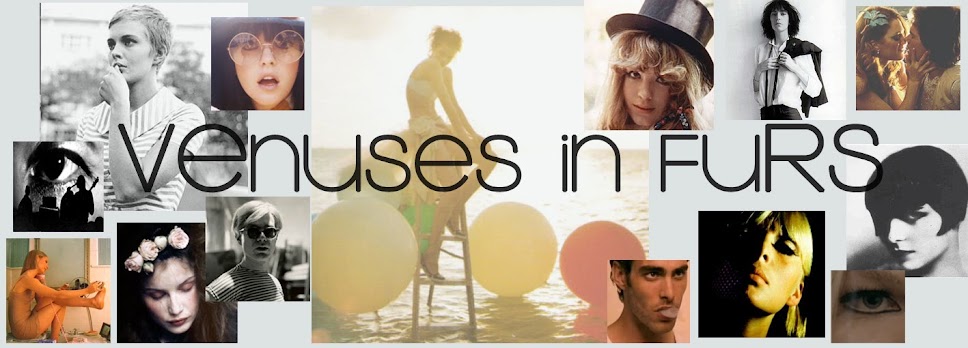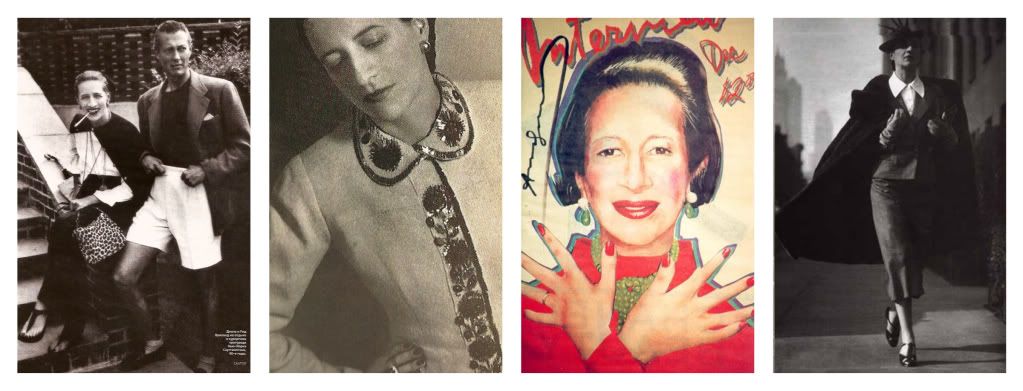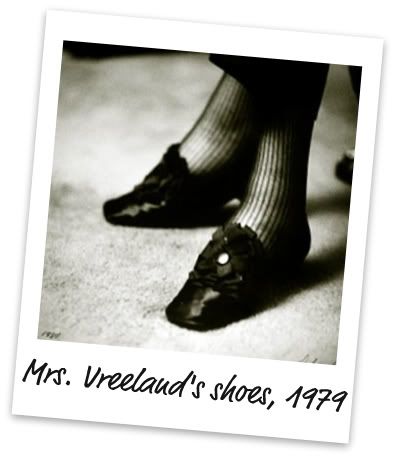Naso aquilino, capelli corvini, quasi blu, lucidi di brillantina e tirati indietro, il viso coperto da strati di cipria bianca, contrastata da squillanti tocchi di rosso cremisi, come una maschera del teatro kabuki; le unghie lunghe e laccate, l'aspetto eccentrico, curato in ogni dettaglio, l'amore per il lusso e l'esagerazione: Diana Vreeland non era mai stata la donna più bella, ma di sicuro era sempre la più attraente, quella che emanava un fascino cui, tuttora, è impossibile resistere. Arrivata, quasi per caso, nella redazione di Harper's Bazaar nel 1936, questa giovane mondana, dotata di un gusto eccezionale, ottenne un successo immediato con la rubrica intitolata "Why don't you?", in cui dispensava consigli assurdi, suggerendo alle lettrici di abbandonare una noiosa versione di loro stesse, ingegnandosi per diventare qualcosa di diverso. Per 26 anni lavorò nella rivista, passando da semplice redattrice a fashion editor, reinventando totalmente questo ruolo, cercando di «dare alla gente quello che non aveva mai sognato di poter desiderare».
Arched nose, dark black hair, almost blue, shiny with grease and pulled back, face covered in white powder layers, contrasting with crimson red touches, like a Kabuki mask. Long lacquered nails, eccentric look, with attention of every single detail, in love with luxury and exaggeration: Diana Vreeland never was the most beautiful woman, but she always was the more attractive one, oozing a charm, which is still impossible to resist. She started working, almost by chance, at Harper's Bazaar Magazine in 1936, and this young socialite, with her extraordinary taste, had a huge and immediate success with the column "Why Don't you?" in which she gave whimsical advices to the readers, telling them to forget their ordinary dull self and be ingenious, making themselves into something else. She worked there for 26 years, starting as a simple editor and becoming fashion editor, completely reinventing that job in her attempt to «give people what they never ever thought they could want».
1. Diana e Reed Vreeland 2. With a Schiaparelli, photo by Louise Dhal-Wolfe 3. portrait by Richard Bernstein for Interview Magazine
Nel 1963 iniziò la sua carriera di direttrice di Vogue. Scendeva dalla sua limousine in tarda mattinata, o all'ora di pranzo, in quella che ormai era la sua divisa: maglione di cashmere, gonna a portafoglio, le famose scarpe a punta, con la suola lucidata, tutto rigorosamente nero. Solo un inverno, nonostante amasse questo colore, scelse di non indossarlo neanche una volta: nel 1966, dopo la morte del marito, rifiutò di farsi confezionare un abito da sera nero, chiedendolo rosso. «Non voglio ricordare a tutti che sono in lutto. Questo è il mio lavoro». Dall'amicizia con Chanel alle cene con Andy Warhol è difficile contare il numero di fotografi, modelle, attori e stilisti che incoraggiò e aiutò a crescere, imponendoli al mondo dalle pagine patinate della sua rivista: Lauren Bacall, Lauren Hutton, Anjelica Houston, Marisa Berenson, Emilio Pucci, Roger Vivier, Manolo Blahnik (lo so, sembra assurdo, ma questo signore esisteva molto prima di Sex and The City!), Missoni e Valentino, passando per Edie Sedgwich, Veruschka, Richard Avedon. Ogni sua scelta editoriale era all'insegna della novità, dell'avanguardia, dell'esagerazione; guardava sempre avanti, un'idea dopo l'altra, illuminata da una visione personale, coraggiosa e irriverente della moda. Provò a realizzare, senza successo, un numero di Vogue stampato al contrario, come un libro giapponese, ritenendo che quello fosse il modo in cui tutti sfogliavano una rivista. Negli anni Sessanta pubblicò la foto di uno dei primi completi di Courregès, un pantalone e un top che lasciava scoperto l'ombelico, ricevendo lettere di protesta da tutto il paese. Il suo era un vero intuito per le novità, un sesto senso innato, il dono di una personalità straordinaria.
In 1963 began her career as Vogue's editor-in-chief. She used to step out her limousine, in the late morning or at lunchtime, dressed in what was her uniform: cashmere sweater, wrap skirt, the famous pointed shoes, polished on the bottoms, everything black, head to toe. Only a winter, although she loved that color so much, she chose not to wear it: in 1966, after her husband passed away, she refused to have an evening dress made in black, instead she asked for it in red. «I don't want to remind anyone that I'm in mourning. That's my business». From her close friendship with Chanel to dinners with Andy Warhol it's almost impossible to count the number of photographers, models, actors and designers she encouraged and helped growing, imposing them to the public, from the glossy pages of her magazine: Laren Bacall, Lauren Hutton, Anjelica Houston, Marisa Berenson, Emilio Pucci, Roger Vivier, Manolo Blahnik (I know, it's unbelievable: this guy existed way before Sex and The City!), Missoni and Valentino, to Edie Sedgwich, Veruschka and Richard Avedon. Every editorial choice she made was devoted to new, avant-garde, exaggeration; she was always looking forward, idea after idea, guided by her personal, brave and irreverent vision of fashion. One time she tried to realize, with no success, an issue of the magazine printed from the back, like a Japanese book, because she thought everyone looked at the magazines that way. In the Sixties she published a photo of one of the first Courrèges' suit, a pair of trousers and a top that revealed the belly and complaining reader's letters arrived from all over the country. She had a real talent for innovation, a sixth-sense, the gift of an outstanding personality.
Left: photos by Francesco Scavullo, New York, 1976 Right: illustration, Lula Magazine
Ma è all'età di 69 anni che iniziò la parte migliore della sua carriera: licenziata da Vogue, diventò consulente per il Costume Institute del Metropolitan Museum di New York. Le sue non erano semplici mostre, ma veri e propri eventi, in cui celebrava con sfarzosi allestimenti i Ballet Russes, le corti dei maharaja indiani, gli scintillanti abiti delle dive di Hollywood, le creazioni di stilisti culto, come Yves Saint Laurent. Impossibile non immaginarla nel lussuoso appartamento al 550 di Park Avenue, un trionfo di rosso, chintz e tappeti persiani, della cui sala da pranzo disse: «Voglio che questo posto sembri un giardino, ma un giardino all'inferno». Diana Vreeland è un'icona. Ma non perchè ha diretto importanti riviste, perchè ha vissuto a New York, lavorando con le personalità più importanti della moda; non lo è per i suoi vestiti o per l'acconciatura, anche se sono questi i dettagli che maggiormente ce la ricordano. E' un'icona perchè stava sempre un passo avanti agli altri, perchè non aveva paura di seguire il suo istinto, non si preoccupava di sbagliare, perchè permetteva a se stessa di avere idee assurde, incomprensibili, irrealizzabili, ma che molto spesso si rivelavano geniali.
But at the age of 69 she was about to begin the most successful act of her career: fired from Vogue, she started working for Metropolitan Museum Costume Institute. She produced exhibitions with a whole new perspective, they were real events, celebrating with luxury settings the Ballet Russes, indian maharaja's courts, the Hollywood stars sparkling dresses and the creations of cult designers as Yves Saint Laurent. It's impossible not to imagine her in the magnificent apartment at 550 Park Avenue, full of red, chintz and Persian carpets; talking about the living room saying: «I want this place to look like a garden, but a garden in hell». Diana Vreeland is an icon. And this isn't because of her job at important fashion magazine, because she lived in New York and worked with the most important people in fashion; nor for her clothes or hair, even if these are the details we remember the most. She is an icon because she was always a step forward, she wasn't afraid of following her instinct, she wasn't terrified by mistakes, she is an icon because she let herself have absurd, unbelievable, impossibile ideas, that most of the time were absolutely great.
Why don't you...
- use a gigantic shell, instead of a bucket to ice your champagne?
- have a yellow satin bed entirely quilted in butterflies?
- tie an enormous bunch of silver balloons on the foot of your child's bed on Christmas Eve?
- paint a map of the world on all four walls of your boys' nursery, so they won't grow up with a provincial point of view?
- have your cigarettes stamped with a personal insignia?
- turn your child into an Infanta for a fancy-dress party?
photo by Deborah Turbeville
Sources:
- D.V. by Diana Vreeland, Da Capo Press, 2003
- New York Magazine article "The Divine Mrs.V" by Eleanor Dwight
- Diana Vreeland: Bazaar Years by John Esten, Katherine Betts, Universe, 2001





7 commenti:
La rubrica "Icons" ti fa venir voglia di mandare l'orologio avanti..per esser più veloci degli altri..
Andrea
I love Diana Vreeland. Her book, D.V. is a great read.
Diana è DIANA.
...altrimenti si sarebbe chiamata GIOVANNA!!!
(certe volte mi rendo conto di essere di una simpatia travolgente)
Great post and great blog :)
thank you so much, really happy you like it!! :D
I enjoyed reading this, I didn't really know of her before.
Posta un commento